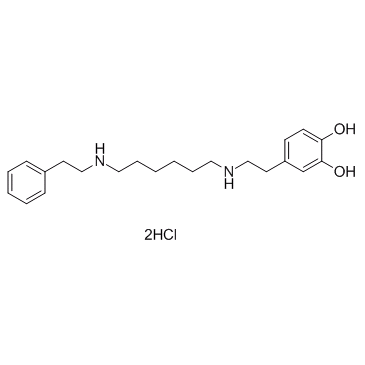Dopexamine hydrochloride

Dopexamine hydrochloride structure
|
Common Name | Dopexamine hydrochloride | ||
|---|---|---|---|---|
| CAS Number | 86484-91-5 | Molecular Weight | 429.42400 | |
| Density | N/A | Boiling Point | 546.7ºC at 760 mmHg | |
| Molecular Formula | C22H34Cl2N2O2 | Melting Point | N/A | |
| MSDS | N/A | Flash Point | 115.1ºC | |
Use of Dopexamine hydrochlorideDopexamine hydrochloride is a β2 adrenergic receptor agonist. |
| Name | Dopexamine Hydrochloride |
|---|---|
| Synonym | More Synonyms |
| Description | Dopexamine hydrochloride is a β2 adrenergic receptor agonist. |
|---|---|
| Related Catalog | |
| Target |
β2 adrenergic receptor[1] |
| In Vitro | Dopexamine is a dopamine analogue with agonist activity at β2 and dopaminergic receptors. Dopexamine can attenuate the systemic inflammatory response, reduce tissue leukocyte infiltration, and protect against organ injury at doses that do not alter global hemodynamics or regional microvascular flow[1]. Dopexamine is a dopamine analog that stimulates β-adrenergic and dopamine 1 and 2 receptors, conferring some vasodilatory effects. Dopexamine reduces the systemic inflammatory response to endotoxin, including cytokine release, endothelial adhesion molecules, and oxidative stress, without substantially changing systemic hemodynamics, either blood pressure or stroke volume[2]. |
| References |
[2]. Hollenberg SM. Dopexamine: immunomodulatory, hemodynamic, or both? Crit Care. 2013 May 13;17(3):143. |
| Boiling Point | 546.7ºC at 760 mmHg |
|---|---|
| Molecular Formula | C22H34Cl2N2O2 |
| Molecular Weight | 429.42400 |
| Flash Point | 115.1ºC |
| Exact Mass | 428.20000 |
| PSA | 64.52000 |
| LogP | 6.00840 |
| Storage condition | 2-8°C |
| Water Solubility | Soluble in water, sparingly soluble in ethanol (96 per cent) and in methanol, practically insoluble in acetone. |
|
The effect of fenoldopam and dopexamine on cytokine and endotoxin release following on-pump coronary artery bypass grafting: a prospective randomized double-blind trial.
Heart Surg. Forum 13(6) , E353-61, (2010) Surgical trauma, exposure to an external circuit, and reduced organ perfusion contribute to the systemic inflammatory response following cardiopulmonary bypass (CPB). Reduced splanchnic perfusion caus... |
|
|
Is dopexamine superior to dopamine in the treatment of multiple trauma patients—A prospective, double-blind, randomised study
Injury 41(5) , 499-505, (2010) Background The goal of this prospective, randomised, double-blind clinical trial study was to assess the effects of dopexamine hydrochloride on organ failure, inflammatory mediators and splanchnic oxy... |
|
|
Hemodynamic effects of dobutamine and dopexamine after cardiopulmonary bypass in pediatric cardiac surgery.
Paediatr. Anaesth. 19(9) , 862-71, (2009) After surgical repair of congenital heart disease, inotropic support is sometimes necessary to wean from cardiopulmonary bypass. In pediatric cardiac surgery, dobutamine and dopamine are often used as... |
| 4-[2-[6-(2-phenylethylamino)hexylamino]ethyl]benzene-1,2-diol,dihydrochloride |